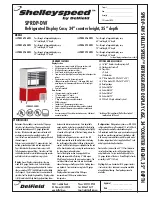
The above spectrum is from a gyroplane rotor that shows the very large × 2
vibration still present after the rotor was balanced. You can see that the
vibration at the rotor RPM (372) was only 0.08 IPS but the × 2 vibration at 750
RPM was 4.23 IPS, that's around 50 times larger!
Unlike, rotor mass imbalance, the × 2 vibration cannot be suppressed by simply
adding weights. It is fundamental to the geometry of a (2 bladed) rotor system
and the physical properties of its components (blades, hub, mast, etc.) The ×
2 vibration can be caused by a variety of reasons. Some possibilities are:
• The rotor “teeter height” is wrong.
• When the blades are perpendicular to the direction of flight more drag is
produced.
Furthermore, the amount of × 2 vibration being produced is influenced by the
flight conditions (rotor speed, airspeed, etc.) At this time, the PB-4 system can
only report the magnitude of the × 2 vibration and it does not offer any
suggestions as to how the level of vibration can be reduced. Perhaps in the
future when the causes of the × 2 vibration are better understood, it will be
able to make helpful suggestions.
8.2. Rotor adjustments
Gyroplane rotors are balanced by making these adjustments:
The balance in the spanwise direction (tip to tip) is commonly
altered by adjusting the amount of weight that is attached to the
Spanwise
Balance
tips of the rotor blades. One of the blades is designated as the
master blade (the other is the slave blade). Our convention is that
mass added to the master blade tip is positive and mass added
to the slave blade tip is negative. So, for example, if we have 3
grams attached to the master blade tip and 1 gram attached to
the slave blade tip, the net result is +2. If we had 3 grams on the
master blade tip and 4 grams on the slave blade tip, the net result
would be -1.
How the weights are attached to the blade tips is gyroplane type
specific. Some gyroplanes do not provide any means to attach
weights to the blade tips. Those that have hollow (extruded) rotor
blades may have mass added to the tips by inserting the mass at
the open root end of the blades and it will find its way to the tip.
The balance in the chordwise direction (side to side) is commonly
altered by shifting the whole rotor (blades and hub bar) left or
Chordwise
Balance
right. Exactly how this is done is gyroplane type specific. Some
machines require you to insert/remove shims, other machines
provide some form of threaded adjuster. In all cases, the amount
of movement required is quite small (fraction of a mm). Our
convention is that a positive value is a shift to the right (when the
www.smartavionics.com
52
Rotor adjustments
Summary of Contents for PB-4
Page 6: ...www smartavionics com vi...
Page 12: ...www smartavionics com 6...
Page 20: ...www smartavionics com 14...
Page 34: ...www smartavionics com 28...
Page 40: ...www smartavionics com 34...
Page 56: ...www smartavionics com 50...
Page 62: ...www smartavionics com 56...
Page 68: ...www smartavionics com 62...
Page 70: ...www smartavionics com 64...
Page 74: ...www smartavionics com 68...
Page 78: ...www smartavionics com 72...


































